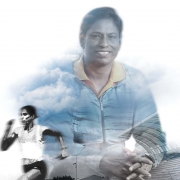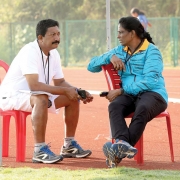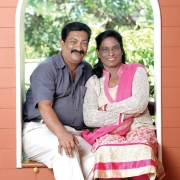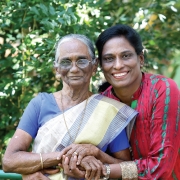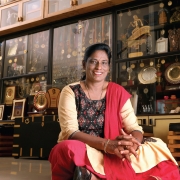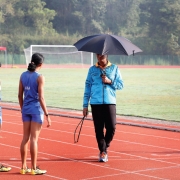
People
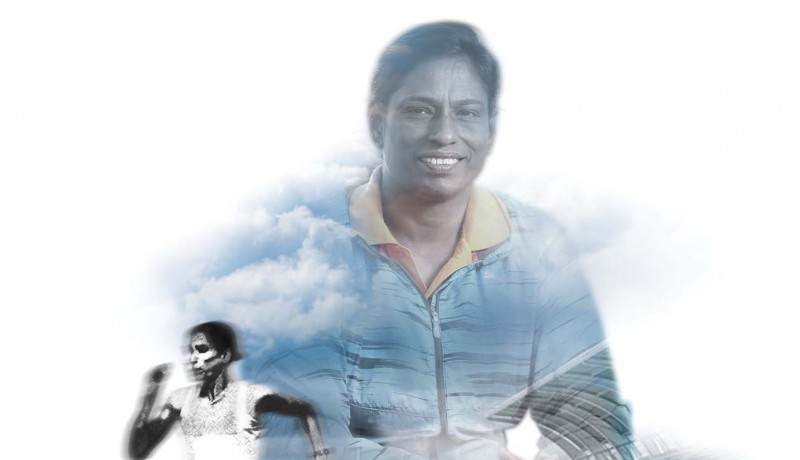
Trailblazer P T Usha has enjoyed a dream run. Now, as a mentor to Gen Next, the sprint queen hopes to bring an Olympic medal in athletics to India, writes Srirekha Pillai
For years, Payyoli, a sleepy hamlet in north Kerala, has been synonymous with Pilavullakandi Thekkeparambil Usha. Even today, Payyoli Express, the pet name for the girl who came 1/100th of a second close to bagging an Olympic medal in athletics for India, is the sole claim to fame for this town, which is otherwise just a blip on the map. On the outdoor wall of Ushus, home to India’s most successful athlete, is a golden embossed figure of her on the track. A large showcase brims with innumerable medals amassed over an eventful career spanning two decades. Pictures on the wall—with American Olympic medallist Carl Lewis, Mother Teresa and Indira Gandhi among others—tell their own stories.
Usha has won more international medals than anybody else in the history of Indian sport. At the Asian Track and Field Meet in Jakarta in 1985, she won five gold medals to set the World Record for most gold medals by a female athlete in a single track meet. And she still holds the National Record for best timing in 200 m, a record she set during her comeback after marriage and childbirth at the age of 34.
The ‘Queen of Indian Track and Field’ was born to E P M Paithal and T V Lakshmi on 27 June 1964, as the fifth of six siblings—Seetha, Pushpa, Shobha, Suma and Pradeep. Discovered by coach and mentor O M Nambiar at the age of 12, she won maximum chocolates from him —an incentive for the best student! In a parallel, years later in Mumbai, another sporting legend in the making, Sachin Ramesh Tendulkar, collected maximum one rupee coins from his coach Ramakant Achrekar for batting well and retaining his wicket. What set these sporting icons apart is not just talent but their drive, determination, strength of character and steely resolve to stay put, whether on the track or the pitch.
At 16, Usha became the youngest Indian athlete to participate in the Olympics. A small-town girl thrust into the global world of competitive sports, she admits, “I felt like Alice in Wonderland then.” Though it was a no-show for her, Usha’s next appearance at the Olympics had an entire nation’s hopes spinning high. On 8 August 1984, she was the crowd favourite for winning the newly introduced 400-m hurdles at the Coliseum in Rome, but lost in a photo finish, crashing a billion hopes. Thirty-two years later, it still rankles. Today, she’s spurred by the dream of bringing that elusive Olympic medal in athletics to India. “I’m on the lookout for that one talent who can do what I missed—win an Olympic medal in athletics. If that happens, I’ll be at peace,” she says. This dream led to the birth of the Usha School of Athletics in Kinalur in Kozhikode in 2002, to spot and train talent. Her spouse V Sreenivasan quit his job with the Central Police Service to help realise his wife’s dream. He talked animatedly to Harmony-Celebrate Age about the couple’s ‘babies’—24 year-old Ujjwal, who is currently a house surgeon at the A J Institute of Medical Sciences in Mangalore, and the 14 year-old Usha School of Athletics.
Usha’s autobiography Golden Girl was published by Penguin in 1987. Recently, with Indian women stealing the show at the Rio Olympics, efforts are on to bring her story alive on the silver screen, with actress Sonam Kapoor evincing a keen interest in the project. Indeed, a framed quotation in her living room, “Attitude: Things turn out best for people who make the best of the way things turn out”, appears to perfectly sum up Usha’s motto in life. Without a doubt, hers is a story of grit, gumption and glory.
EXCERPTS FROM AN INTERVIEW
When did you realise sport was your calling in life?
I’ve been unusually active and agile from childhood. I would always engage in household chores that required tremendous physical agility. Those days, there were no mixers and grinders and cooking involved a lot of physical labour. Even at school, I would be in the forefront of all sporting events. Our physical education teacher Balakrishnan ‘master’ probably saw some potential in me and asked me to compete with the school champion, who was three years older. My uncle, a teacher in the same school, also encouraged me to participate in sports. There was hardly any sport training in schools those days; we were made to run and jump a couple of weeks before the district meet. It was totally unscientific. Today, we know that training has to be made lighter in the weeks preceding a competition to conserve energy and avoid wear and tear.
During one of those practice sessions, my dad saw me attempting the high jump. Being the youngest daughter, I was his pet. He didn’t want me to get hurt and asked me to stay away from the ground. When I didn’t turn up for practice the next day, my uncle sat my dad down and convinced him that sport would only do my health good. That was it!
Can you take us through your days at the sports school?
I had just completed Class 7 when the first sports school for girls in the state was launched in Kannur in 1978. I stood first in all the selection rounds. At the school, we had a regimented life. We would wake up by 5 am and be on the school ground for practice from 6 am to 8.30 am. We would attend school, after which it would be back to sports training for two hours from 4.30 pm.
During inter-school sports meets, I would run without spikes but still beat students from other schools. I was completely raw then; I didn’t even know what ‘warm up’ was! [Chuckles.] I would sit in a corner watching kids from other schools go through the warm-up routine. I was under the impression that these kinds of physical exercises before the race would sap my energy. Now, when I look back, it’s so silly!
When I went from the school for the first state meet, I lost in the heats. I watched the gold medallist from afar and decided I would put in what was needed to go up on the victory stand the next year. Thereafter, there was no looking back. Next year, I won gold across events such as high jump, long jump, shot put and the 200-m race. I won gold medals at the national meet too.
Did anybody in your family have any inkling that you would make it big?
Once, an astrologer who had come to my ancestral home to check my mom’s horoscope took a look at mine too. He said, “This girl will become well known.” We hail from a tiny village; my grandmother was really worried when she heard it. Those days, good girls were supposed to get married and settle down. It took some effort on my uncle’s part to convince my grandmother that the astrologer meant it in a positive way! Nobody in my family has a sporting background, and at that time no one had any clue that I would take up sports as a career. The only person in my family to participate and win in sports events at school was my eldest sister Seetha. However, I’m fortunate enough to have had the support of my parents and uncles through my journey.
It’s said that crowds would follow when you ran at the Payyoli beach in shorts.
During summer vacations, when the school was shut, I would run on the beach. My coach O M Nambiar, who stayed close by, would accompany me sometimes. Mostly, it would be me racing all alone. People were not used to seeing girls in shorts those days. They would gather on the beach to watch me! Some of them would even tease me. Thankfully, that didn’t deter me. Gradually, they got used to it and stopped following me.
You have had a remarkable association with your coach.
I met him for the first time when I joined the Kannur sports school. Nambiar sir was our coach. Though he had around 40 students, I was his favourite. He would distribute chocolates to those who would follow his instructions and exercise well. I would end up collecting chocolates on most days!
In the 1980 Moscow Olympics, you were the youngest Indian athlete. Being a small-town girl, what were your apprehensions?
I was just 16 and knew nobody. I was mostly on my own. I felt like Alice in Wonderland. It was the first time I saw a synthetic track. To my horror, I had to run on it. The Olympic village with large stadiums, similar flats and chauffeur-driven cars in identical colours left me completely confounded. I got lost many times, going in circles trying to locate my flat!
Is there any truth in the rumours of track rivalry with your contemporaries M D Valsamma and Shiny Wilson?
Valsamma was one year senior to me while Shiny was a year junior. We were friends then; we are friends still. The competition between us was healthy and limited to the ground. We never took it home with us.
Valsamma’s coach allegedly stated she could beat you at the Olympics.
The discipline of hurdles was introduced for the first time in the 1984 Olympics. One has to qualify in the interstate meet to go to the Olympics. I decided to compete on behalf of the Athletics Federation of India (AFI). When I reached the ground, the athletes from Kerala and their coaches called for my boycott, saying that if I ran, they wouldn’t run. I was disheartened and withdrew. Thereafter, I represented the Railways in the Open Nationals and qualified for the Olympics. When I was selected, Valsamma’s coach said that if she gets 10 days of training on a good ground, she would be the champion.
Have such statements deterred you?
Not at all! He didn’t say it to my face. I read about it in the newspapers. However, I used it to motivate me further. I kept a cutting of the newspaper article under my pillow. It spurred me on to practice more. My focus was unshakeable. I’ve always lived for sports; I still do!
As a sportsperson, diet plays a major role in your life. How has your diet changed over the years?
We didn’t have nutritionists back then. My coach would advise me on my diet. As a sprinter, my diet was rich in carbohydrates. I would never overdo it though, stopping when I felt almost full. I was also advised by my coach to increase my calorie intake. For that, I started having tea with sugar, a habit I’m finding hard to forego. My focus now is on weight management. At my age, I can’t over-exercise as it can lead to injuries. My diet is meagre, comprising biscuits with morning tea; a small cup of oats/ one idli/one dosa for breakfast; fruits, vegetables, meat and one bowl of rice for lunch; and fruits, vegetables and two chapattis for dinner. However, I ensure my body is well hydrated, a habit I picked up from my sporting days.
You came 1/100th of a second close to winning an Olympic medal in 1984. Does it still haunt you?
Athletics is the toughest event at the Olympics. To reach the finals, one has to beat over 65-70 athletes over five to six heats. About 20 days before the Olympics, I participated in the pre-Olympics, where I came first, beating Judi Brown of the US who was eventually the silver medallist at the Olympics. That gave me confidence. Though I came second in the heats of the 400-m hurdles of the Olympics, I finished first in the semi-finals. That boosted my confidence further. I started strong, but a false start by another athlete led to the race being recalled. Generally, races are recalled only if a foul has been committed. I was disappointed and tense, and my restart was sluggish. I was not able to get over the brilliant takeoff that had been nullified. However, I made up midway through and would have won if only I had lunged forward at the finish. Being accustomed to winning races with a comfortable margin, I was not in the habit of lunging forward. What rankles me even today is that I came so close to winning it. Had I missed out on the medal by 10 or 15 m, it would not have felt this bad!
When you did exceptionally well in Jakarta in 1985, Lydia de Vega from Philippines and her father allegedly hurled doping charges against you.
Lydia and I used to compete in both 100-m and 200-m races. While I would generally beat her in 200 m, she would win 100 m sometimes, while I would at other times. At the Jakarta meet, where I won five gold medals, doping charges were levelled against me after each and every event. I would be participating in two to three events per day, and would spend my waking hours competing on the track and in the doping examination room.
Do you think that it was a deliberate tactic to demoralise you?
I doubt that. I won five gold medals and one bronze at the meet. Maybe she would have thought I was on drugs [chuckles]! Even in the relay, while Lydia got the baton much before me—she got it second while I got it sixth—I ran fast enough to bag the bronze. So, it’s quite possible that she had her doubts. What upset me was that instead of preparing for the next day’s event, I would be spending my time cooped up in the doping examination room. However, I learnt to take it all in my stride.
There were talks of retirement following your marriage in 1991. Nonetheless, you staged a comeback in 1993. What led to the change of plan?
In the 1990 Asian Games, I bagged only a silver medal. Till then I had been winning gold. So, I wasn’t very happy to call it a day and settle down. However, my husband has always been a pillar of strength. He knew that I wanted to go back and end on a better note. It wasn’t easy as I had ballooned to 84 kg from 62 kg after giving birth. Seeing my weight, Nambiar sir was sceptical of my dreams. My husband encouraged me to get fit and make a comeback. Unfortunately, I was given a wrong set of exercises by my new coach, which led to meniscus tear and ligament strain. The knee injury meant I couldn’t attempt speed-boosting exercises. Still, running with that injury, I managed to bag the bronze in the 200-m and 400-m races at the Asian Track Federation Meet at Fukkowakka in Japan and a gold medal and two bronze medals at the Asian Championships in 1998. But my main dream of winning an Olympic gold remained just that—a dream!
Tell us about the Usha School of Athletics.
It was set up with the intention of having a training centre of international standard in India, and to win an Olympic gold in athletics for the country. Our students have been doing well at sub-junior championships and school meets. Children from all over Kerala and other states participate in the talent scout. We make selections based on certain criteria such as drive, talent, physical fitness, mental toughness, etc. Once selected, training, food and accommodation are free, thanks to corporates and sports lovers who fund the school. My kids have been doing exceptionally well at the Junior International level, including Under 18, Under 16 and Under 20. They have also won Asia Junior Championship medals. I hope to see one of my students win an Olympic medal in the near future!
Has your son Ujjwal shown any inclination toward sports?
I would have loved to see him in sports. He showed some interest in swimming initially, but it didn’t last. Ujjwal has finished MBBS, and is a house surgeon at present. He’s a football fanatic, though, never missing a chance to watch matches. He’s passionate about fitness and joins me for early morning jogs and exercises whenever he’s at home.
How do you unwind?
I enjoy gardening, listening to old Hindi and Malayalam songs, and cleaning. I used to be a big fan of Mohammed Rafi. Cooking is also a kind of stress-buster for me. Ujjwal is into salads. He gives me a lot of recipes from the Internet to make a variety of salads. Now, even my husband enjoys salads. I had a tough time finding lettuce in Kozhikode. I started getting it from Mangalore, where Ujjwal studies. Recently, I found a small shop close by that sells lettuce and other exotic vegetables. My family also enjoys meen molasia [Kerala-style fish curry] cooked by me.
Bollywood has made biopics on Milkha Singh and Mary Kom. Do you think your story should be on celluloid as well?
I feel it’s a nice idea if it helps in motivating others. My husband is in talks with some people who have shown interest. I would want it to be a realistic portrayal and nothing glossy.
How can we better our sporting culture?
We should give more importance to grassroots-level training. There’s no point in throwing your hands up in the Olympic year. Training should be systematic and scientific. We have to catch kids young and train them well. Though a lot of money is being channelled into sports of late, it’s not really being utilised wisely. Our athletes should be sent to international competitions all over Europe. Such exposure will stand them in good stead during the Olympics. At the school, we have Tintu Luka and Jishna Mathew, all young and raring to go. If they get enough international exposure, I’m sure they can bag Olympic medals.
Honours galore
1984: Arjuna Award; Padma Shri
1984-1989: Best Athlete in Asia Award
1985-1986: World Trophy for Best Athlete
1985: Declared ‘Greatest Woman Athlete’ at the Jakarta Asian Athletic Meet
1986: Adidas Golden Shoe Award for the Best Athlete at the Seoul Asian Games
1999: Honoured with the Sportsperson of the Century Award by the Indian Olympic Association
Milestones
- Became the first Indian woman to reach the final of an Olympic event in 1984 at Los Angeles
- Missed an Olympic medal by 1/100th of a second in the 400-m hurdles in 1984
- Holds the World Record for most gold medals—for 100 m, 200 m, 400 m, 400-m hurdles and 4×400 relay at the 1985 Asian Track and Field Meet at Jakarta—won by a female athlete in a single track meet
- Won four gold medals and one silver at the 1986 Asian Games in Seoul
Photographs by Vivek R Nair Featured in Harmony — Celebrate Age Magazine December 2016
you may also like to read
-
For the love of Sanskrit
During her 60s, if you had told Sushila A that she would be securing a doctorate in Sanskrit in the….
-
Style sensation
Meet Instagram star Moon Lin Cocking a snook at ageism, this nonagenarian Taiwanese woman is slaying street fashion like….
-
Beauty and her beast
Meet Instagram star Linda Rodin Most beauty and style influencers on Instagram hope to launch their beauty line someday…..
-
Cooking up a storm!
Meet Instagram star Shanthi Ramachandran In today’s web-fuelled world, you can now get recipes for your favourite dishes at….



